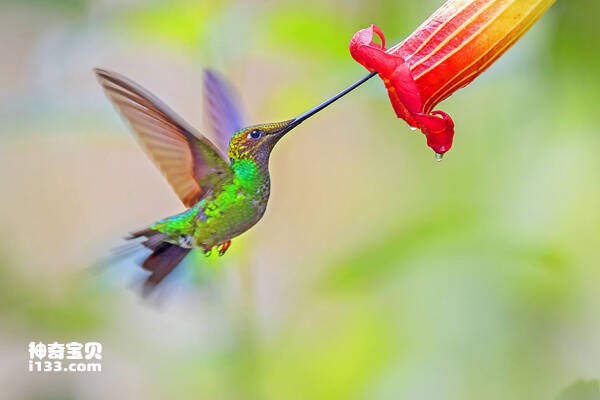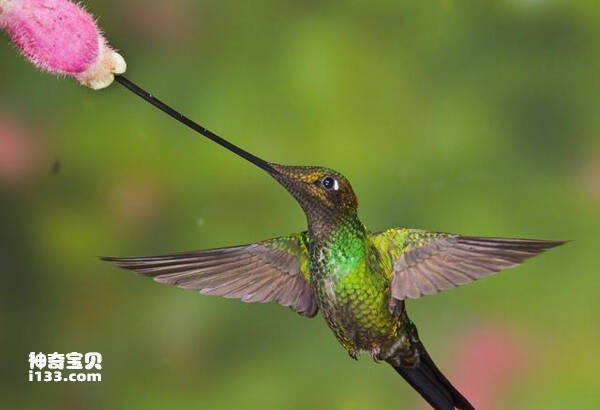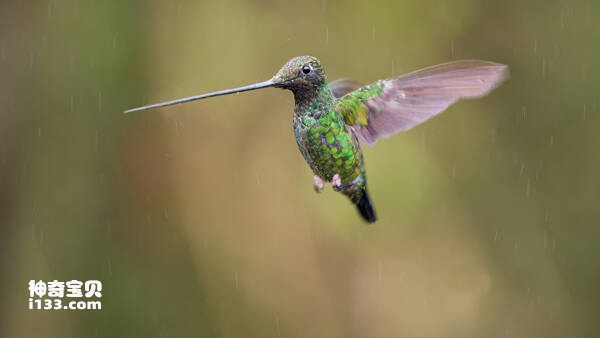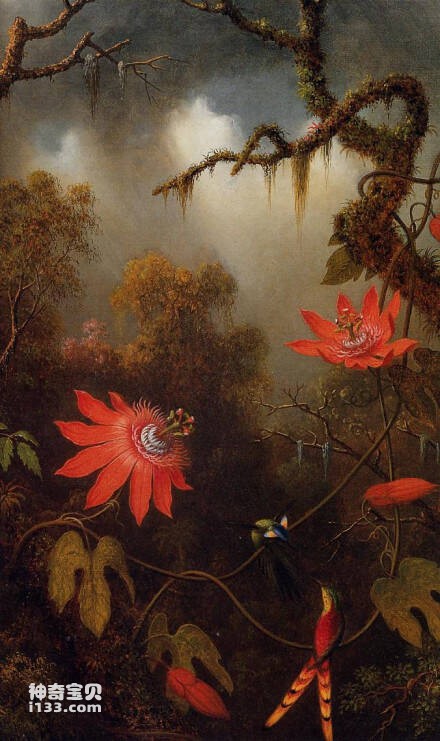Ensifera ensifera
IUCN
LCBasic Information
Scientific classification
- name:Ensifera ensifera
- Scientific Name:Ensifera ensifera,Sword-billed Hummingbird
- Outline:Climbing birds
- Family:
Vital signs
- length:About 14 cm
- Weight:About 12g
- lifetime:No textual research information is available
Feature
The world's longest hummingbird
Distribution and Habitat
It is found in Bolivia, Colombia, Ecuador, Peru and Venezuela.
It is native to the Andes Mountains of South America, rising above 2,500 meters in dense forests.
Appearance
The sword-billed hummingbird is 14 cm long, has an average beak of 8 cm and weighs about 12 grams. It is one of the largest species of hummingbird. The plumage is bright, the mouth is slender, the eyes are large and bright, the head is brown, the upper part of the wings is yellowish-green, the lower part is brown, the other feathers of the body are copper-green, and the whole body shines with metallic luster. Its tubular beak is slender like a sword, the longest up to 10.5 cm, more than half of its body length, very beautiful. In addition, it flies like a bee, its wings flap quickly, and produces a buzzing sound like a bee, so it is named knifebill hummingbird.
Knife-billed hummingbird feathers are delicate, smooth, very beautiful, but also has a special reflective effect. Every time it flies against the sun, it can reflect a riot of different colors, enough to beat the beautiful rainbow. Especially when it carries out the flipping action, because of the different Angle, the color c
Details
Sword-billed Hummingbird (Ensifera ensifera) Sword-billed Hummingbird, no subspecies.

The swordbill hummingbird's life is very strange, there are many different from other birds. Nectar from the Central American climbing plant Passion flower is its main source of food. The sworn-billed hummingbird's long beak is suited to the passion flower's 11.4cm long crown structure, which allows it to reach into its trumpet shaped flowers to extract nectar. When feeding, it does not need to stop its body in the flower branches, but displays its superb flight technology, hovering its body in the air. Because its tongue is tubular, like the syringes used by doctors, when it inserts its mouth into the crown of the flower, the tongue can quickly reach out at the front of the mouth and lick the nectar with the cilia on the tip of the tongue. When the cilia are full of nectar, the tongue retreats into the mouth and licks the nectar away. This method of feeding is accurate and convenient, and is unparalleled in the colorful bird world.
Knifebill hummingbirds feed mainly on the nectar of brightly colored, fragrant flowers of trees, herbs, shrubs and epiphytes. Prefer flowers that are high in sugar (usually red and tubular), and seek out and actively protect these flowers that contain high energy nectar. Their tongue is longer than a bird's beak, and the hyoid bone is coiled inside the skull, allowing the tongue to flex and retract at a high rate of 13 times per second with its long, expandable, straw-like tongue. Because hovering is so physically demanding, the sword-bill hummingbird must eat tens of thousands of times a day, and can consume more than half of its body weight in a single day.

This delicate, unspoken partnership between the sword-billed hummingbird and the passion flower benefits both. The sword-billed hummingbird gets food and the passion flower gets pollinated and fertilized. This is why the sword-billed hummingbird is known as the "matchmaker of flowers" because it helps plants pollinate while licking nectar. Usually it flies around under the flowers, looking for food, when the pollen will stick to its feathers, and then it flies and carries the pollen to other flowers, completing the pollination process for these plants.
Because the knife-billed hummingbird has a special lifestyle, its metabolism is also very strong and prominent. Its normal body temperature is about 41 ° C, and the heartbeat can reach more than 600 times per minute. The advantage of the nectar food it eats is that it is rich in glucose, which can enter the blood immediately to participate in energy metabolism, but the disadvantage is that this energy is consumed very quickly. In order to maintain body temperature and timely supplement the large amount of energy consumed during intense flight, it must keep eating, eating tens of thousands of times a day, and the amount of food is also very amazing, and the weight of food eaten every day and night is more than half of its own body weight.

Although the sword-billed hummingbird is small in size, it is very brave in character and is not afraid of violence. When encountering birds that are much larger than themselves, they also dare to fight with them, and they will constantly gallop around each other's bodies, making a buzzing sound, often making each other dizzy and tinnitus, and fleeing defeat.
Hummingbirds are "polygamous", after mating with the male birds, the female birds build a separate nest, the nest is cup-shaped, woven together with plant fibers, the outside of the nest with moss and other green camouflage, placed in a protected position in the bush or tree. The nest is made of soft plant fiber, animal hair, down liner, and spider webbing and other viscous material structure to give enough elastic quality. Each nest produces an average of 2 white eggs, which are incubated by the female bird alone for about two weeks, and the female bird protects and feeds the chicks alone, regurgitating food mainly partially digested nectar and insects, and the female bird spits the food down the throat of the chicks, and the tip of her long beak goes directly into the belly of the chicks. The chicks are left alone in the nest after 12 days, and the birds can leave the nest in about 7 to 10 days. The male defends his territory and his flower food.

The sword-billed hummingbird's beautiful image and delicate movements have also won the love of many artists. In the exhibition hall of the Boston Museum in the United States, there is an original world famous painting stored, the title is: Passion flower and Hummingbird. This is the work of the American oil painter Martin Johnson Heade, and the main subjects in the painting are two liflike sworn-billed hummingbirds perched on a hanging vine, surrounded by beautiful red flowers.

Listed on the International Union for Conservation of Nature (IUCN) 2016 Red List of Threatened Species ver 3.1 - Not Threatened (LC).
Protect wild animals and eliminate wild meat.
Maintaining ecological balance is everyone's responsibility!








